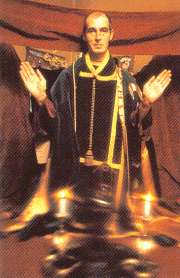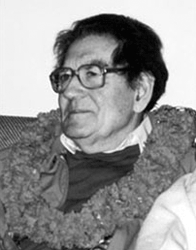
Dianic Wicca, also known as Dianic Witchcraft, is a modern pagan goddess tradition focused on female experience and empowerment. Leadership is by women, who may be ordained as priestesses, or in less formal groups that function as collectives. While some adherents identify as Wiccan, it differs from most traditions of Wicca in that only goddesses are honored.

Gardnerian Wicca, or Gardnerian witchcraft, is a tradition in the neopagan religion of Wicca, whose members can trace initiatory descent from Gerald Gardner. The tradition is itself named after Gardner (1884–1964), a British civil servant and amateur scholar of magic. The term "Gardnerian" was probably coined by the founder of Cochranian Witchcraft, Robert Cochrane in the 1950s or 60s, who himself left that tradition to found his own.

Wicca, also known as "The Craft", is a modern pagan, syncretic, earth-centered religion. Considered a new religious movement by scholars of religion, the path evolved from Western esotericism, developed in England during the first half of the 20th century, and was introduced to the public in 1954 by Gerald Gardner, a retired British civil servant. Wicca draws upon ancient pagan and 20th-century hermetic motifs for theological and ritual purposes. Doreen Valiente joined Gardner in the 1950s, further building Wicca's liturgical tradition of beliefs, principles, and practices, disseminated through published books as well as secret written and oral teachings passed along to initiates.

A Book of Shadows is a book containing religious text and instructions for magical rituals found within the Neopagan religion of Wicca. Since its conception, it has made its way into many pagan practices and paths. The most famous Book of Shadows was created by the pioneering Wiccan Gerald Gardner sometime in the late 1940s or early 1950s, and which he utilised first in his Bricket Wood coven and then in other covens which he founded in following decades. The Book of Shadows is also used by other Wiccan traditions, such as Alexandrian Wicca and Mohsianism, and with the rise of books teaching people how to begin following non-initiatory Wicca in the 1970s onward, the idea of the Book of Shadows was then further propagated amongst solitary practitioners unconnected to earlier, initiatory traditions.
The Feri Tradition is an American neo-pagan tradition related to Neopagan witchcraft. It was founded in the west coast of the United States between the 1950s and 1960s by Victor Henry Anderson and his wife, Cora Anderson. Practitioners have described it as an ecstatic tradition, rather than a fertility tradition. Strong emphasis is placed on sensual experience and awareness, including sexual mysticism, which is not limited to heterosexual expression.
Alexandrian Wicca or Alexandrian Witchcraft is a tradition of the Neopagan religion of Wicca, founded by Alex Sanders who, with his wife Maxine Sanders, established the tradition in the United Kingdom in the 1960s. Alexandrian Wicca is similar in many ways to Gardnerian Wicca, and receives regular mention in books on Wicca as one of the religion's most widely recognised traditions.
Odyssean Wicca is a Wiccan tradition created in Toronto, Ontario, Canada in the late 1970s. Its principal founders were Tamarra and Richard James. Most of its practitioners today live in Ontario, but it also has members in Eastern Canada and the United States. The tradition differs from other initiatory Wiccan traditions in its emphasis on preparation of its members for public priesthood.
Frank Stewart Farrar was an English screenwriter, novelist and prominent figure in the Neopagan religion of Wicca, which he devoted much of his later life to propagating with the aid of his seventh wife, Janet Farrar, and then his friend Gavin Bone as well. A devout communist in early life, he worked as a reporter for such newspapers as the Soviet Weekly and the Daily Worker, and also served in the British army during the Second World War. He was responsible for writing episodes for such television series as Dr. Finlay's Casebook, Armchair Theatre and Crossroads, and for his work in writing radio scripts won a Writer's Guild Award. He also published a string of novels, written in such disparate genres as crime, romance and fantasy.

Blue Star Wicca is one of a number of Wiccan traditions, and was created in the United States in the 1970s based loosely on the Gardnerian and Alexandrian traditions.

Janet Farrar is a British teacher and author of books on Wicca and Neopaganism. Along with her two husbands, Stewart Farrar and Gavin Bone, she has published "some of the most influential books on modern Witchcraft to date". According to George Knowles, "some seventy five percent of Wiccans both in the Republic and Northern Ireland can trace their roots back to the Farrars."

Alex Sanders, born Orrell Alexander Carter, who went under the craft name Verbius, was an English occultist and High Priest in the modern Pagan religion of Wicca, responsible for founding, and later developing with Maxine Sanders, the tradition of Alexandrian Wicca, also called Alexandrian Witchcraft, during the 1960s.

Victor Henry Anderson was an American priest and poet. He was co-founder of the Feri Tradition, a modern Pagan new religious movement established in California during the 1960s. Much of his poetry was religious in nature, being devoted to Feri deities.
Eleanor "Ray" Bone who also went under the craft name Artemis, was an influential figure in the neopagan religion of Wicca. She claimed to have been initiated in 1941 by a couple of hereditary witches in Cumbria. She later met and became friends with Gerald Gardner, and was initiated into Wicca, becoming the High Priestess in one of his covens. She was a friend of several important figures in Wicca during the modern Witchcraft revival, including "Dafo", Jack Bracelin, Patricia Crowther, Doreen Valiente and Idries Shah. Bone was a close confidant of Gardner's initiator Dafo, and she reported that the New Forest coven was a hereditary coven that followed the old ways of the Hampshire region, and that they traced their origins to the time of the death of King William Rufus in the Norman era.
The history of Wicca documents the rise of the Neopagan religion of Wicca and related witchcraft-based Neopagan religions. Wicca originated in the early 20th century, when it developed amongst secretive covens in England who were basing their religious beliefs and practices upon what they read of the historical witch-cult in the works of such writers as Margaret Murray. It also is based on the beliefs from the magic that Gerald Gardner saw when he was in India. It was subsequently founded in the 1950s by Gardner, who claimed to have been initiated into the Craft – as Wicca is often known – by the New Forest coven in 1939. Gardner's form of Wicca, the Gardnerian tradition, was spread by both him and his followers like the High Priestesses Doreen Valiente, Patricia Crowther and Eleanor Bone into other parts of the British Isles, and also into other, predominantly English-speaking, countries across the world. In the 1960s, new figures arose in Britain who popularized their own forms of the religion, including Robert Cochrane, Sybil Leek and Alex Sanders, and organizations began to be formed to propagate it, such as the Witchcraft Research Association. It was during this decade that the faith was transported to the United States, where it was further adapted into new traditions such as Feri, 1734 and Dianic Wicca in the ensuing decades, and where organizations such as the Covenant of the Goddess were formed.

Wiccan views of divinity are generally theistic, and revolve around a Goddess and a Horned God, thereby being generally dualistic. In traditional Wicca, as expressed in the writings of Gerald Gardner and Doreen Valiente, the emphasis is on the theme of divine gender polarity, and the God and Goddess are regarded as equal and opposite divine cosmic forces. In some newer forms of Wicca, such as feminist or Dianic Wicca, the Goddess is given primacy or even exclusivity. In some forms of traditional witchcraft that share a similar duotheistic theology, the Horned God is given precedence over the Goddess.

Vivianne Crowley is an author, university lecturer, psychologist, and a High Priestess and teacher of the Wiccan religion.

Neopagan witchcraft, sometimes referred to as The Craft, is an umbrella term for some neo-pagan traditions that include the practice of magic. These traditions began in the mid-20th century, and many were influenced by the witch-cult hypothesis; a now-rejected theory that persecuted witches in Europe had actually been followers of a surviving pagan religion. The largest and most influential of these movements was Wicca. Some other groups and movements describe themselves as "Traditional Witchcraft" to distinguish themselves from Wicca.
Georgian Wicca is a tradition, or denomination, in the neopagan religion of Wicca. In its organisation, it is very similar to British Traditional Wicca groups such as Gardnerian Wicca, however, it does not trace its initiatory line to one of the old English covens.
In Modern English, the term Wicca refers to Wicca, the religion of contemporary Pagan witchcraft. It is used within the Pagan community under competing definitions. One refers to the entirety of the Pagan Witchcraft movement, while the other refers explicitly to traditions included in what is now called British Traditional Wicca.

Modern paganviews on LGBT people vary considerably among different paths, sects, and belief systems. There are some popular neopagan traditions which have beliefs often in conflict with the LGBT community, and there are also traditions accepting of, created by, or led by LGBT individuals. The majority of conflicts concern heteronormativity and cisnormativity.












